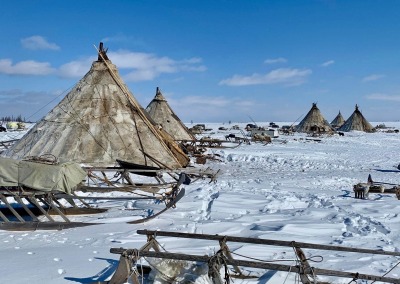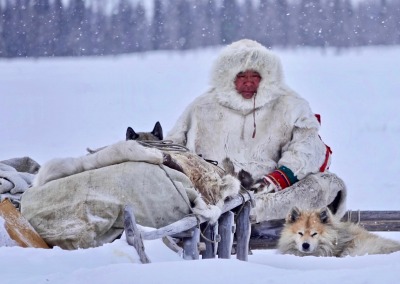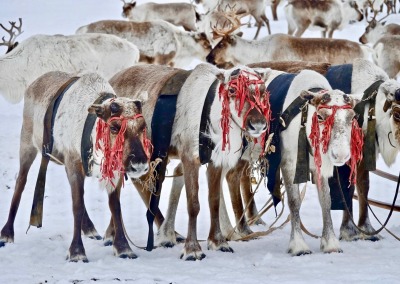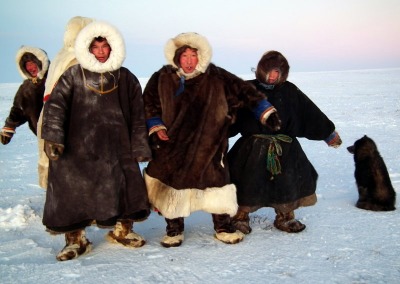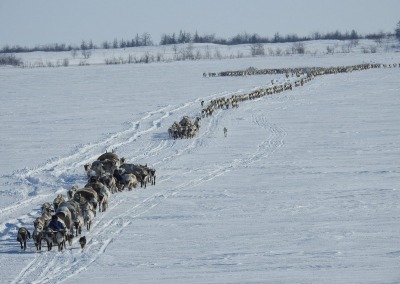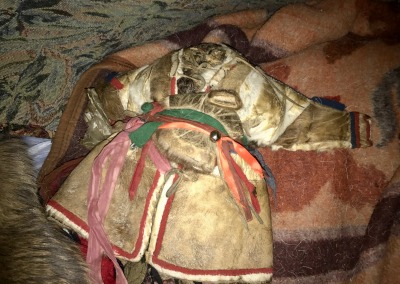Yamal Peninsula: most migratory Nenets
Tour Overview
Highlights
- Living in a traditional chum (reindeer-fur teepee) with a family of Nenets reindeer herders for six nights
- Getting involved in the daily life of the encampment, including nomadic migrations
- Observing a herd of several thousand reindeer
- Trying traditional Nenets cuisine of reindeer meat and Arctic fish such as chir and muksun.
- Seeing the Northern Lights if you are lucky
- Learning about Nenets culture and religion
- Observing the full range of traditional Nenets clothing including gus jackets and women’s hats
- Enjoying the beautiful forest tundra of Nadym District or the treeless Arctic tundra of the Yamal Peninsula
- Visiting gulag camps (from January to April)
Itinerary
Day 1: Fly into Salekhard and travel to Yar-Sale or Nadym
Trekol all-terrain vehicle and English-speaking guide meet you at Salekhard airport. Which direction we travel from Salekhard will depend on the exact location of the nomad camp we are to visit. They migrate up to 2000km every year and it is hard to predict their exact location this far in advance. However, they will be somewhere in between Nadym and Yar-Sale. If they are closer to Nadym (most likely from January to April), we will travel there, overnight and take snowmobiles to the nomad camp the next day. If they are closer to Yar-Sale (most likely in November, December and May) we will travel there, overnight and take snowmobiles to the nomad camp the next day. Either way we will have a long drive by Trekol (7 hours to Yar-Sale or 10 hours to Nadym) on a zimnik (temporary winter road). While most of Russia has no roads, towns and villages become accessible in winter thanks to a huge network of zimniki – temporary winter roads built on the frozen surfaces of rivers or just using compacted snow and ice. The Nadym zimnik is particularly interesting as it runs parallel to the 501 Salekhard-Igarka Railway of Death, a 1500km railway that Stalin tried to build along the Arctic Circle using prisoners of gulag concentration camps for labour. It was abandoned after his death but in many places the tracks remain, as do plenty of bridges and the gulag camps where the prisoners lived. Some have around 20 – 30 wooden houses still standing as well as watchtowers and barbed wire fences.
Overnight in a hotel in Yar-Sale or Nadym.
Day 2: Travel by snowmobile to an encampment of Nenets nomads
Travel through the vast, empty tundra in wooden box sledges attached to the back of a snowmobile to an encampment of nomadic Nenets reindeer herders. These nomads are among the most traditional tribal people in the world and have the longest nomadic migration routes in the world. They wear clothing made of reindeer fur sewn using reindeer sinew as thread. They live in conical teepees made of reindeer fur and known as chums. Travel time to reach them by sledge can be anything from 30 minutes to 5 hours.
These Nenets migrate up to 2000km every year, transporting their chums and all their possessions on hand-carved, wooden, reindeer-drawn sledges. They speak a language completely unrelated to Russian and sacrifice reindeer to the gods of an ancient shamanistic religion. We will spend the next few days immersing ourselves in this ancient culture, hopefully joining them on a migration or two and of course looking out for the Northern Lights.
Overnight with a nomadic family in their chum.
Days 3 - 7: Immersion in the daily life of the Nenets
Live with the nomads, eating and sleeping in their chums (reindeer-fur teepees). There will be no fixed itinerary for these days. Guests will merely observe and take part in the daily lives of the nomads and immerse themselves in this ancient culture. If visiting In November, December, early January, late March, April or May guests will very likely get to join the Nenets on their epic migrations.
Daily life could include herding reindeer (up to 11,000 in one herd), lassoing reindeer with reindeer rawhide lassoes, strangling reindeer with ropes then eating the raw meat and drinking the blood (the Nenets’ favourite meal), migrating to a new campsite, cutting trees for firewood, collecting ice or snow for water, making new sledges, sewing fur clothing, and so on.
Day 8: Return to Nadym or Yar-Sale
Return to Nadym or Yar-Sale by snowmobile. Overnight in hotel.
Day 9: Return to Salekhard
Return to Salekhard. Overnight in hotel.
Day 10: Spare day in Salekhard.
Today is a contingency day in Salekhard in case bad weather delays our return from Nadym or Yar-Sale. In winter on the Yamal Peninsula blizzards can sometimes make travel impossible. This spare day is particularly necessary on this itinerary as we have two travel days to get back from the nomad camp to Salekhard and we could be delayed on either one of them. On about 10% of trips, this spare day saves us from missing our flights back to Moscow.
On this day we can visit the excellent museum, the 16th-century wooden fortress of Obdursk, the market square where nomads come to sell meat and fish, the Arctic Circle monument, the mammoth monument and more.
Overnight in hotel.
Day 11: Fly home
Day 11: Transfer to Salekhard airport. Fly out to Moscow Domodedovo, arriving at 10 a.m.
Tour price
Number of people: {{ currentPerson }}
Price per person: $ {{parseFloat(price).toFixed(0)}}
PRICE INCREASE FOR ADDING AN EXTRA DAY (OR PRICE REDUCTION FOR SHORTENING TRIP BY ONE DAY)
Number of people: {{ currentPerson }}
Price per person: $ {{parseFloat(price).toFixed(0)}}
Price includes:
- All transport and transfers on Yamal
- 6-wheeler Trekol all terrain vehicle with driver, petrol and all driver’s expenses
- Snowmobiles to reach the nomad camp with drivers, petrol, all drivers’ expenses and attached walled box sledges for clients to ride in.
- All accommodation throughout the trip in twin or double rooms. In Salekhard these rooms will be ensuite. In Yar Sale they will not be ensuite. With the nomads you will be staying with a family in their chum (tepee made of reindeer fur) and sleeping on warm, soft reindeer furs. Single supplement (available in Salekhard only) is $175 per person.
- All meals while with the nomads
- All permits required for the region
- English- and Russian-speaking guide with knowledge of Nenets culture and religion on the level of an anthropologist and long personal relationship with the Nenets to be visited
- Fees to the Nenets for hosting us
- Letter of invitation for 30-day Russian tourist visa
- Satellite phone for emergency calls
Price does not include:
- Transfers, accommodation or guiding in Moscow. This can be added at extra cost if so desired.
- Flights to and from Salekhard. These can be added at extra cost if so desired.
- Food in Salekhard, Yar-Sale or Nadym. All meals can be included for $240 per person.
- Personal travel insurance or medical insurance
- International flights
- Personal expenses
- Western clothing or equipment. You will need a sleeping bag, western boots, very warm western clothing and so on. Boots, trousers and jacket rated down to -45°C can be rented for $105 per person. Sleeping bags rated down to -60°C can be rented for $185 per person. Prices include delivery to you in Salekhard at the beginning of the trip and collection from your hotel at the end.
- Satellite phone for personal or work-related calls. You can purchase minutes for $2 per minute.
- A generator for charging your kit. Nenets camps usually have these and they are usually enough for tourists and photographers. However, for film crews they are not powerful enough to charge large amounts of kit at once. If you want to purchase your own 2-kilowatt generator in Salekhard together with 50 meters of cable, 10 sockets for charging, 100 liters of petrol and 2 liters of oil this will cost $1050.
- Private Trekol rental during your stay with the nomads. Rental of a private Trekol all terrain vehicle costs $500 per Trekol per day and includes driver, petrol and all the driver’s expenses. This is not usually required for tourists and photographers but for film crews with large amounts of kit and an increased need for mobility it is usually essential. It can also be useful for people who plan to do the 24-hour migration across the Gulf of Ob in late December or early January, as it gives you a place to warm up and escape from the cold.

